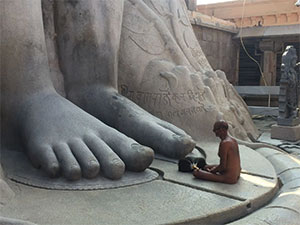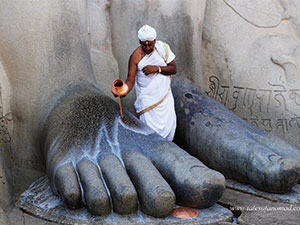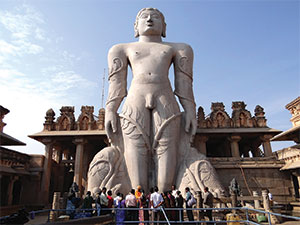Shravanabelagola (Kannada: ಶ್ರವಣ ಬೆಳಗೊಳ, romanized: śravaṇa beḷagoḷa, pronunciation: [ ɕɾɐ.ʋɐˈɳɐ bɛ.ɭɐ.go.ɭɐ ] ) is a town located near Channarayapatna of Hassan district in the Indian state of Karnataka and is 144 km (89 mi) from Bengaluru. The Gommateshwara Bahubali statue at Shravanabelagola is one of the most important tirthas (pilgrimage destinations) in Jainism, one that reached a peak in architectural and sculptural activity under the patronage of Western Ganga dynasty of Talakad. Chandragupta Maurya is said to have died on the hill of Chandragiri, which is located in Shravanabelagola, in 298 BCE after he became a Jain monk and assumed an ascetic life style.
Gommateshwara statue, Akkana Basadi, Chandragupta basadi, Chamundaraya Basadi, Parshvanath Basadi and inscriptions of Shravanabelagola group of monuments are listed as Adarsh Smarak Monument by Archaeological Survey of India.
Shravanabelagola is located at 11 km (6.8 mi) to the south-east of Channarayapatna in the Channarayapatna taluk of Hassan district of Karnataka. It is at a distance of 51 km (32 mi) south-east of Hassan, Karnataka, the district centre. It is situated at a distance of 12 km (7.5 mi) to the south from the Bengaluru-Mangaluru road (NH-75), 18 km (11 mi) from Hirisave, 78 km (48 mi) from Halebidu, 89 km (55 mi) from Belur, 83 km (52 mi) from Mysuru, 144 km (89 mi) from Bengaluru, the capital of Karnataka and 222 km (138 mi) from Mangaluru.
Sacred places are spread over two hills, Chandragiri and Vindyagiri, and also among the villages at the foothills.
Shravanabelagola “White Pond of the Shravana” is named with reference to the colossal image of Gommaṭa – the prefix Śravaṇa serves to distinguish it from other Belagolas with the prefixes Hale- and Kodi-, while Beḷagoḷa “white pond” is an allusion to the pond in the middle of the town.
The Sanskrit equivalents Śvetasarovara, Dhavalasarovara and Dhavalasarasa used in the inscriptions that support this meaning. There are more than 560 inscriptions in Shravabelagola.
Some inscriptions mention the name of the place as Beḷgoḷa, which has given rise to another derivation from the plant Solanum ferox (hairy-fruited eggplant). This derivation is in allusion to a tradition which says that a pious old woman completely anointed the colossal image with the milk brought by her in a gullakayi or eggplant. The place is also designated as Devara Beḷgoḷa “White Pond of the God” and Gommaṭapuram “city of Gommaṭa” in some epigraphs.
Shravanabelagola has two hills, Chandragiri and Vindhyagiri. Acharya Bhadrabahu and his pupil Chandragupta Maurya are believed to have meditated there. Chandragupta Basadi, which was dedicated to Chandragupta Maurya, was originally built there by Ashoka in the third century BC. Chandragiri also has memorials to numerous monks and Śrāvakas who have meditated there since the fifth century AD, including the last king of the Rashtrakuta dynasty of Manyakheta. Chandragiri also has a famous temple built by Chavundaraya.
The 58-feet tall monolithic statue of Gommateshwara is located on Vindyagiri Hill. It is considered to be the world’s largest monolithic statue. The base of the statue has an inscriptions in Prakrit, dating from 981 AD. The inscription praises the king who funded the effort and his general, Chavundaraya, who erected the statue for his mother. Every twelve years, thousands of devotees congregate here to perform the Mahamastakabhisheka, a spectacular ceremony in which the statue is anointed with Water, Turmeric, Rice flour, Sugar cane juice, Sandalwood paste, saffron, and gold and silver flowers. Recently Mahamastakabhisheka was held in 2018 during feb month. The next Mahamastakabhisheka will be held in 2030.
Shravanabelagola, nestled by the Vindhyagiri and Chandragiri Hills, protected by the monolith Bhagwan Bahubali, and home to over 2,300 years of Jain heritage, is a veritable picture postcard of our history and heritage spanning the centuries. In the town of Shravanabelagola, stands a colossal rock-cut statue of Gommateshwara Shri Bahubali. About eight hundred odd inscriptions which the Karnataka Archeological Department has collected at the place are mostly Jaina and cover a very extended period from 600 to 1830 A.D. Some refer even to the remote time of Chandragupta Maurya and also relate the story of the first settlement of Jains at Shravanabelagola. That this village was an acknowledged seat of learning is proved from the fact that a priest from here named Akalanka was in 788 A.D. summoned to the court of Himasitala at Kanchi where having confuted the Buddhists in public disputation, he was instrumental in gaining their expulsion from the South of India to Ceylon.






